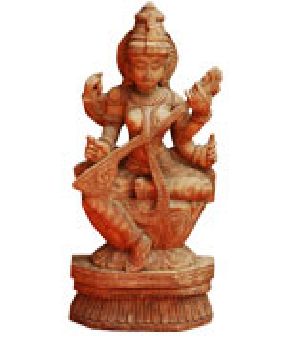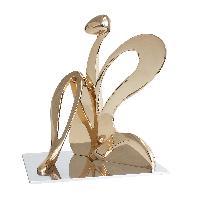










Sculptures
The three dimensional object created out of a non living material like metal or concrete is known as sculpture. It is usually a representation of a figure or an abstract expression. It is an ancient form of art that was used for carving out massive temples, deities and figurines that today are the cultural heritage. In our country, sculptures are a part of every Indian, be it either in the form of idols whom we worship or a show piece adorning the living room. Sculptures can be in the form of a bust, statue or architectural relief as seen in the centuries old monuments all around the country. Indian sculptures are diverse and of a variety of types. Here is a brief overview of the types of sculptures in India: Types of Indian Sculptures Wooden Sculptures – The bark of trees like Neem, Redwood and Cedar are used as carving material. These wooden sculptures are famous in heavily forested regions of India like Himachal Pradesh, Assam, Gujarat and Kerala. These are made by the subtractive method. Marble Sculptures – Another fine example of the subtractive method, marble sculptures are famous in the states of Rajasthan and Uttar Pradesh. Marble is well known as a weather resistant material and so, sculptures made of marble are popular handicrafts in India.Stone Sculptures – Stone as a sculpting material has been used from the prehistoric times. Rock cut sculptures are nothing but stone sculptures. Sandstone, Limestone, Marble and Granite are popular stones that have been in use since centuries. The technique used is subtractive. India not only has statues made of stone, there are a number of monuments all around the country that has relief sculptures like in the Khajuraho Temples, Sun Temple in Konark, Vittala Temple in Hampi, Mahabalipuram and Varaha Cave Temples.Terracota Sculptures – Terracota is one of the oldest materials used for sculpting. Literally meaning baked earth in Italian, this is basically porous clay that is molded, fired in a kiln and subsequently cooled and colored. Being easily available, re-usable and lower priced, sculptors today extensively use it all around India and the world. This is one of the best known examples of additive sculptures.Metal Sculptures – Metal in its alloy form has properties of strength, being easily moldable and ductility that make it a well known material for casting sculptures. Bronze is an alloy of copper and tin, and it can be made into a sculpture using processes like sand casting and lost-wax casting. Bronze sculptures made in South India between the 9th and 13th centuries are world renowned. Other sculpting alloys are brass, bell metal and steel. Metals like zinc, copper, iron, nickel and silver are also used for making sculptures either alone or alloyed with another one or more metals. Sculptures made by metal represent the additive method. Indian Sculptures down the Ages Sculpture in India is as old as civilization itself. The first sculptures were found during the excavations in Mohenjodaro, in the present Pakistan. These were dated between 2,500 and 1,500 BC. These sculptures not only helped gather more information about the culture prevalent in those times, it also showed the sculpting technical knowledge that the Indian subcontinent had such a long time ago. Through the centuries, sculptures became more expressive and definite. Here is a brief overview of the evolution and history of sculpture in India: Indus Valley Sculptures - After the stone carved Bust of a Nobleman and bronze casted Dancing Girl in the Indus Valley Civilization, came the era when Buddhism was propagated around 1st to 3rd century BC. Teachings of Lord Buddha were the main theme for sculptures during this time. The rulers of the Mauryan and Kushana Empires built stupas and pillars to spread the concepts of humanity, morality and non violence. The popular sculpting elements were animals, nature, Yakshis or a representation of the symbol of fertility, and Jataka stories that are about Buddha’s earlier lives. The Ashokan Pillar, Sanchi Stupa and Bodhi Tree of Barhut are famous sculptures of this time.Gupta Age of Sculptures - In the 14th century came the era, which is dubbed as the Classical period for Art including sculptures. With the establishment of the Gupta Empire, all the 3 main religions – Hindu, Buddhist and Jain, gained impetus to explore more in sculpturing. During this time, figures got more importance than nature. Statues of gods and goddesses were sculpted from stone and sandstone. Several schools of sculpture came up including Mathura School and Gandhara School, which emphasized on a particular style of look and sculpture-work. Figures were more intricately carved to depict emotion and beauty. Well known sculptures of the period between the 4th and 6th centuries were the red sandstone Buddha in Mathura, Sheshashayi Vishnu at the Deogarh Temple and the standing Buddha at Sarnath.Medieval Age of Sculptures - During the medieval age, sculptures became more ornamented rather than pious and simplistic, which was typical of the last age. Kingdoms all across the country contributed to Indian sculpture in a number of ways. Rulers in regions of the present Rajasthan, Gujarat, Orissa, Tamil Nadu, Karnataka and Andhra Pradesh built palaces, temples and other monuments and adorned them with small to big sculptures. Most of these had religious themes. Many of them were idols of Hindu Gods and Goddesses like the bronze Nataraja made in the Chola Dynasty. The temples were also sculpted to create pop-out images (relief sculptures) depicting the life of gods and goddesses like the Briheshwara Temple, granite sculptures in the Mahabalipuram temples and the Sun Temple in Konark.Modern Age of Sculptures - After the advent of Muslim rulers, architecture was given more importance than sculptures and therefore, the golden period of sculptures came to an end. During the British era, Indian sculpture got the first taste of western sculpture styles. The Bengal School of Art was a major school for sculptures patronized by the Tagore family. The early 20th century brought about a new age in Indian sculpture – the Contemporary or Modern era. This era includes the present times. Contemporary Sculptures in India are influenced by the western concepts of pseudo-realism, minimalism and abstract expressionism. Famous sculptors of the modern era include Debiprasad Roy Chowdhury, Satish Gujral, Ramkinkar Baij, Raghav Kaneria, Pradosh Dasgupta, K.G. Subramanyan, and Sankho Chaudhuri. Regardless of the modern influences there are a number of tribesmen in India, who have kept their sculpture true to the Indian aesthetics. The Bastar, Gadwaa, and Naga tribals are noted for their sculpture-works.

Wooden Elephant Sculptures
300 Per Piece
Features : Smooth finish, Intricate carving, Eye catching designs .
Best Deals from Sculptures

bronze sculptures
bronze sculptures, Handicrafts, hand carved teakwood, antiques, Painting

Brass Ramdarbar
11,650 Per Piece
Color : Yellow
Size : H-20,L-12,W-7 (inch)
Brand Name : Thar handicrafts Gallery pvt Ltd
Material : Brass
God Statue Type : Ramdarbar
Usage/Application : Worship
:
Gold Plated : No
Minimum Order Quantity : 1 Piece

Golden Brass Ganesh Statue
16,000 Per Piece
Packaging Type : Box
Size : 1 - 1.5 Feet (Height)
Material : Brass
Color : Golden (Gold Plated)
Minimum Order Quantity : 1 Piece

feng shui idols
feng shui idols

ceramic sculpture
ceramic sculpture, Copper Bird House, mail boxes, hand knit sweaters

gold plated statues
gold plated statues, Gold Jewellery, Silver Jewellery, Artifacts

Brass Sculpture
Brass Sculpture, Silk Carpets, Semi Precious Stones, Sandalwood

artistic statues
artistic statues, Chocolates

Sculptures
Sculptures, Led Glow Sticks, pottery, Paper Products, Painting

figurine
figurine, candles holders